As the season of end-of-year testing and projects approaches, don’t forget to make time for “just for fun” independent reading. This week’s column includes reviews of recently published, engaging books that will set the tone for enjoyable summer reading.
Ages 4–8
Animalicious: A Quirky ABC Book. Anna Dewdney & Reed Duncan. Ill. Claudia Boldt. 2019. Penguin.
 “The world is full of animals / of every single kind. / This book contains some special ones / that you won’t often find.” Young readers will have fun exploring the animal oddities in this quirky alphabet book. Colorful, cartoon portraits offer clues to understanding the nonsensical names created by clever wordplay, puns, and double entendres. For example, the letter “P” is represented by a green, pear-shaped “pearrot,” a blushing “polar bare,” and a “piethon” wrapped around the “P” with its mouth open, ready to eat the pie perched on the end of its tail. Readers will have fun deciphering some of the more challenging names, such as “macawbre” (a macaw dressed in a Poe-inspired coat).
“The world is full of animals / of every single kind. / This book contains some special ones / that you won’t often find.” Young readers will have fun exploring the animal oddities in this quirky alphabet book. Colorful, cartoon portraits offer clues to understanding the nonsensical names created by clever wordplay, puns, and double entendres. For example, the letter “P” is represented by a green, pear-shaped “pearrot,” a blushing “polar bare,” and a “piethon” wrapped around the “P” with its mouth open, ready to eat the pie perched on the end of its tail. Readers will have fun deciphering some of the more challenging names, such as “macawbre” (a macaw dressed in a Poe-inspired coat).
—CA
Bikes for Sale. Carter Higgins. Ill. Zachariah OHora. Ill. 2019. Chronicle.
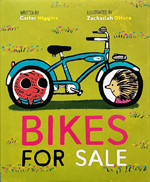 Maurice (a chipmunk) always rode his yellow bicycle around town, selling lemonade from his mobile stand. Lotta (a porcupine) always rode her red bike through the woods, collecting sticks in the basket to hand out all over town. Unfortunately, fate steps in one day for Maurice and Lotta as their bikes are wrecked in separate accidents. “But what looked like a small stick was really a smashup, and that was the end of this one...and what looked like some petals was really some peels, and that was the end of that one.” Fortunately, fate steps in once more with a chance encounter at Sid’s bike shop, where Maurice and Lotta find a bicycle built for two made from recycled parts from their wrecked ones. Young readers will enjoy this humorous tale of a serendipitous friendship as it unfolds in colorful, richly detailed acrylic illustrations.
Maurice (a chipmunk) always rode his yellow bicycle around town, selling lemonade from his mobile stand. Lotta (a porcupine) always rode her red bike through the woods, collecting sticks in the basket to hand out all over town. Unfortunately, fate steps in one day for Maurice and Lotta as their bikes are wrecked in separate accidents. “But what looked like a small stick was really a smashup, and that was the end of this one...and what looked like some petals was really some peels, and that was the end of that one.” Fortunately, fate steps in once more with a chance encounter at Sid’s bike shop, where Maurice and Lotta find a bicycle built for two made from recycled parts from their wrecked ones. Young readers will enjoy this humorous tale of a serendipitous friendship as it unfolds in colorful, richly detailed acrylic illustrations.
—SD
Flubby Is Not a Good Pet! (Flubby #1). J. E. Morris. 2019. Penguin.
 Disappointingly, Flubby, a chubby cat with an aloof attitude, doesn’t do anything that other kids’ pets do. Flubby does not sing like Kim’s pet bird, catch a ball like Sam’s dog, or jump like Jill’s frog. Even when it begins to rain, Flubby does not heed the warning to run and slowly ambles to the house. When thunderous KA-BOOMs frighten them both, however, the young narrator adds, “But he needs me…. And I need him,” and they cuddle up. The simple text with short, repetitive sentences and uncluttered, expressive cartoon-like illustrations make this book and simultaneously published Flubby Will Not Play with That fun-to-read fare for beginning readers.
Disappointingly, Flubby, a chubby cat with an aloof attitude, doesn’t do anything that other kids’ pets do. Flubby does not sing like Kim’s pet bird, catch a ball like Sam’s dog, or jump like Jill’s frog. Even when it begins to rain, Flubby does not heed the warning to run and slowly ambles to the house. When thunderous KA-BOOMs frighten them both, however, the young narrator adds, “But he needs me…. And I need him,” and they cuddle up. The simple text with short, repetitive sentences and uncluttered, expressive cartoon-like illustrations make this book and simultaneously published Flubby Will Not Play with That fun-to-read fare for beginning readers.
—CA
I’m a Baked Potato! Elise Primavera. Ill. Juana Medina. 2019. Chronicle.
 Readers of all ages will get a laugh out of this endearing story with vibrant illustrations about a potato-loving lady and her cherished little brown dog named Baked Potato. One day, Baked Potato gets separated from the lady, and as he walks farther and farther searching for her, he gets lost. Along the way, Baked Potato encounters an angrybig dog who calls him a groundhog and a hungry fox who sees him as a yummy bunny. These responses to his pleas for help leave poor Baked Potato questioning his identity. Is he a baked potato? A groundhog? A bunny rabbit? Finally, a wise owl helps Baked Potato discover his true self as a dog who can use his keen sense of smell to find his way back home.
Readers of all ages will get a laugh out of this endearing story with vibrant illustrations about a potato-loving lady and her cherished little brown dog named Baked Potato. One day, Baked Potato gets separated from the lady, and as he walks farther and farther searching for her, he gets lost. Along the way, Baked Potato encounters an angrybig dog who calls him a groundhog and a hungry fox who sees him as a yummy bunny. These responses to his pleas for help leave poor Baked Potato questioning his identity. Is he a baked potato? A groundhog? A bunny rabbit? Finally, a wise owl helps Baked Potato discover his true self as a dog who can use his keen sense of smell to find his way back home.
—SD
Most Marshmallows. Rowboat Watkins. 2019. Chronicle.
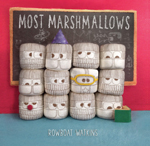 Most marshmallows settle for ordinary lives of watching TV, eating dinner with their families, and falling asleep to dreams of nothing. These marshmallows go to school to learn to be squishy, to stand in rows, and to not breathe fire. “But some marshmallows / somehow secretly know / that all marshmallows / can do anything / or be anything / they dare to imagine.” Watkins’ humorous collage illustrations, which feature marshmallows with human-like characteristics in familiar scenes at home and school (created with construction, cardboard, and found objects), and a lyrical text offer a child-friendly message to live boldly and dream big that will stretch children’s imaginations.
Most marshmallows settle for ordinary lives of watching TV, eating dinner with their families, and falling asleep to dreams of nothing. These marshmallows go to school to learn to be squishy, to stand in rows, and to not breathe fire. “But some marshmallows / somehow secretly know / that all marshmallows / can do anything / or be anything / they dare to imagine.” Watkins’ humorous collage illustrations, which feature marshmallows with human-like characteristics in familiar scenes at home and school (created with construction, cardboard, and found objects), and a lyrical text offer a child-friendly message to live boldly and dream big that will stretch children’s imaginations.
—SD
Ages 9–11
How to Properly Dispose of Planet Earth. Paul Noth. 2019. Bloomsbury.
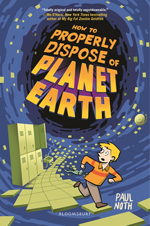 Eleven-year-old Happy Conklin Jr. is busy deciding how he will ask his crush, Nevada Everly, to be his lab partner at school when his lizard, Squeep!, starts bringing him shells, kazoos, and other mysterious doodads. Happy soon realizes the vanishing lizard may be using a second portal in his manic sister’s “Doorganizer,” an infinite closet powered by a black hole. Now, Happy not only must find the courage to speak to Nev but also travel through Squeep!’s portal to save planet Earth from disappearing into a black hole forever. Paul Noth’s cartoon drawings and comic-style panels add to the fun of reading this middle-grade science fiction novel. Readers will also get a kick out of How to Sell Your Family to the Aliens (2018), the first book in Paul Noth’s series.
Eleven-year-old Happy Conklin Jr. is busy deciding how he will ask his crush, Nevada Everly, to be his lab partner at school when his lizard, Squeep!, starts bringing him shells, kazoos, and other mysterious doodads. Happy soon realizes the vanishing lizard may be using a second portal in his manic sister’s “Doorganizer,” an infinite closet powered by a black hole. Now, Happy not only must find the courage to speak to Nev but also travel through Squeep!’s portal to save planet Earth from disappearing into a black hole forever. Paul Noth’s cartoon drawings and comic-style panels add to the fun of reading this middle-grade science fiction novel. Readers will also get a kick out of How to Sell Your Family to the Aliens (2018), the first book in Paul Noth’s series.
—SD
Just Like Rube Goldberg: The Incredible True Story of the Man Behind the Machines. Sarah Aronson. Ill. Robert Neubecker. 2019. Beach Lane/Simon & Schuster.
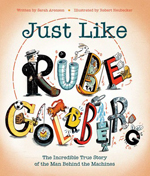 This engaging picture book biography tells the life story of Reuben Garrett Lucius Goldberg (1883–1970), who gained recognition as a “famous inventor without ever inventing anything at all.” Young Rube loved to draw, but to please his father he studied engineering. He hated being an engineer and quit his first job with the San Francisco Department of Water and Sewers after just six months. Determined to become a newspaper cartoonist, he drew and drew until he eventually got a job as a cartoonist at the New York Evening Mail. It was his cartoons about inventions that solved problems in crazy, complicated ways—Rube Goldberg machines—that made him famous. Robert Neubecker’s full-color illustrations cleverly pay homage to Goldberg’s creativity. “The Only Sanitary Way to Lick a Postage Stamp” and seven other of Goldberg’s original black-and-white cartoons are reproduced on the endpapers. Back matter includes additional information on Goldberg’s life and work and sources.
This engaging picture book biography tells the life story of Reuben Garrett Lucius Goldberg (1883–1970), who gained recognition as a “famous inventor without ever inventing anything at all.” Young Rube loved to draw, but to please his father he studied engineering. He hated being an engineer and quit his first job with the San Francisco Department of Water and Sewers after just six months. Determined to become a newspaper cartoonist, he drew and drew until he eventually got a job as a cartoonist at the New York Evening Mail. It was his cartoons about inventions that solved problems in crazy, complicated ways—Rube Goldberg machines—that made him famous. Robert Neubecker’s full-color illustrations cleverly pay homage to Goldberg’s creativity. “The Only Sanitary Way to Lick a Postage Stamp” and seven other of Goldberg’s original black-and-white cartoons are reproduced on the endpapers. Back matter includes additional information on Goldberg’s life and work and sources.
—CA
Klawde: Evil Alien Warlord Cat. Johnny Marciano & Emily Chenowith. Ill. Robb Meommaerts. 2019. Penguin Workshop/Penguin.
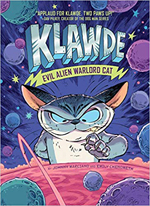 When he’s exiled from the planet Lyttyrboks and transported across space to Earth, deposed Lord High Emperor Wyss-Kuzz vows to return and take revenge. The transported feline lands at the Bannerjee’s home in the small Oregon town of Elba where Raj, who is unhappy about the family’s move from Brooklyn, bargains with his parents to keep the fearsome cat, who’s given the name Klawde, if he attends Camp Eclipse. In alternating chapters, Klawde (who learns English and mind-melds with Raj so they can communicate) and Raj relate the events of a summer in which Klawde develops a means of teleporting back to Littyrboks and Raj struggles to survive nature camp. Klawde does successfully take off and return to Lyttyrboks and Raj completes “Camp Apocalypse” but that’s not the end of this funny sci-fi story because “the evil alien warlord cat” makes an unexpected return to Oregon. Readers can immediately read the next published volume, Enemies.
When he’s exiled from the planet Lyttyrboks and transported across space to Earth, deposed Lord High Emperor Wyss-Kuzz vows to return and take revenge. The transported feline lands at the Bannerjee’s home in the small Oregon town of Elba where Raj, who is unhappy about the family’s move from Brooklyn, bargains with his parents to keep the fearsome cat, who’s given the name Klawde, if he attends Camp Eclipse. In alternating chapters, Klawde (who learns English and mind-melds with Raj so they can communicate) and Raj relate the events of a summer in which Klawde develops a means of teleporting back to Littyrboks and Raj struggles to survive nature camp. Klawde does successfully take off and return to Lyttyrboks and Raj completes “Camp Apocalypse” but that’s not the end of this funny sci-fi story because “the evil alien warlord cat” makes an unexpected return to Oregon. Readers can immediately read the next published volume, Enemies.
—CA
Ages 12–14
Bake Like a Pro! (Maker Comics). Falynn Koch. 2019. First Second/Roaring Brook.
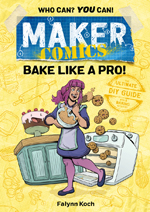 Young wizard Sage is disappointed in her apprentice assignment with alchemist and baking master, Wizard Korian. When she ignores helpful hints from basic ingredients (they talk), misuses baking tools, and doesn’t follow the step-by-step instructions in the spell book (a recipe book), her first baking project, a classic pound cake, is a disaster. Readers learn that baking is “a tangible form of magic” by joining Sage in the enchanted kitchen to learn the science behind baking from Korian. By working along with Sage and Korian in this fun-filled, “ultimate DIY guide” with eight baking activities, readers can learn to bake like a pro. Back matter includes recipes, notes on baking methods, baking tips, conversion and measurement charts, and references. Fix a Car! is a second book in First Second’s new informational graphic novel series.
Young wizard Sage is disappointed in her apprentice assignment with alchemist and baking master, Wizard Korian. When she ignores helpful hints from basic ingredients (they talk), misuses baking tools, and doesn’t follow the step-by-step instructions in the spell book (a recipe book), her first baking project, a classic pound cake, is a disaster. Readers learn that baking is “a tangible form of magic” by joining Sage in the enchanted kitchen to learn the science behind baking from Korian. By working along with Sage and Korian in this fun-filled, “ultimate DIY guide” with eight baking activities, readers can learn to bake like a pro. Back matter includes recipes, notes on baking methods, baking tips, conversion and measurement charts, and references. Fix a Car! is a second book in First Second’s new informational graphic novel series.
—CA
Revenge of the EngiNerds. Jarrett Lerner. 2019. Aladdin/Simon & Schuster.
 In the sequel to EngiNerds (2017),Ken, Dan, Edsley, and the other EngiNerds return to track down the last one of the food-eating, “butt-blasting” robots that presumably caused the power outage in town and led to the disappearance of all the food at Food-Plus. But when an alien-crazed girl with a suitcase of gadgets and theories on alien activity shows up, the alliance of the group quickly becomes threatened. Will Ken find the last robot in time to restore his good standing with the EngiNerds? Are aliens really to blame for the bizarre weather of late? Organized into mini chapters of two or three pages each, this sci-fi adventure will keep middle graders reading in anticipation of what wacky things will happen next.
In the sequel to EngiNerds (2017),Ken, Dan, Edsley, and the other EngiNerds return to track down the last one of the food-eating, “butt-blasting” robots that presumably caused the power outage in town and led to the disappearance of all the food at Food-Plus. But when an alien-crazed girl with a suitcase of gadgets and theories on alien activity shows up, the alliance of the group quickly becomes threatened. Will Ken find the last robot in time to restore his good standing with the EngiNerds? Are aliens really to blame for the bizarre weather of late? Organized into mini chapters of two or three pages each, this sci-fi adventure will keep middle graders reading in anticipation of what wacky things will happen next.
—SD
Ages 15+
I Love You So Mochi. Sarah Kuhn. 2019. Scholastic.
 Kimiko Nakamura, who has been accepted at a prestigious art school, seems to be on track to fulfill her artist mother’s dream of Kimi being recognized as an up-and-coming Asian American artist in the Los Angeles area, although she would rather be sewing Kimiko Originals than painting. Accepting an invitation from her estranged maternal grandparents to visit them in Japan over spring break becomes Kimiko’s means of escaping her problems. When she meets handsome Akira Okamoto (who works part time as a costumed mochi mascot to attract customers to his uncle’s mochi shop), his offer to be her guide in exploring Kyoto soon becomes a journey of self-discovery. While visiting cultural sites, eating delicious mochi, and having her new friendship blossom into a romantic relationship, she discovers that her passion for fashion design promises amazing experiences for the future. A delightfully sweet and funny novel.
Kimiko Nakamura, who has been accepted at a prestigious art school, seems to be on track to fulfill her artist mother’s dream of Kimi being recognized as an up-and-coming Asian American artist in the Los Angeles area, although she would rather be sewing Kimiko Originals than painting. Accepting an invitation from her estranged maternal grandparents to visit them in Japan over spring break becomes Kimiko’s means of escaping her problems. When she meets handsome Akira Okamoto (who works part time as a costumed mochi mascot to attract customers to his uncle’s mochi shop), his offer to be her guide in exploring Kyoto soon becomes a journey of self-discovery. While visiting cultural sites, eating delicious mochi, and having her new friendship blossom into a romantic relationship, she discovers that her passion for fashion design promises amazing experiences for the future. A delightfully sweet and funny novel.
—CA
Skye Deiter is an elementary classroom teacher in Harrisburg, Pennsylvania, and a recent graduate from Pennsylvania State Harrisburg’s Masters in Literacy Education Program. Carolyn Angus is former director of the George G. Stone Center for Children's Books, Claremont Graduate University, in Claremont, California.
These reviews are submitted by members of the International Literacy Association's Children's Literature and Reading Special Interest Group (CL/R SIG) and are published weekly on Literacy Daily.